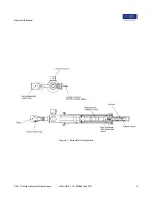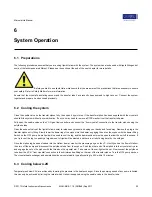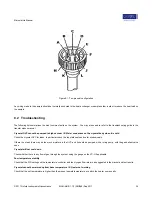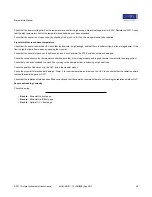
Microstat He Manual
6.5
Controlling at a set temperature
Select the channel on the temperature controller corresponding to the sensor which will be used to control the system. Select the desired
temperature on the Mercury iTC and switch the Mercury iTC heater control to
Auto
.
It is not necessary to cool the cryostat to base temperature before you set the required temperature. If the temperature controller is set to
the required temperature at the beginning of the cooldown, the cryostat should cool to the set temperature and the temperature controller
should hold it at this point.
The Helium flow should then be optimised so that the heater output of the temperature controller is not too high. In general, the flow should
be reduced until the steady heater output is at a suitable level.
If you are using an Auto LLT system, the flow and heater voltage will be automatically optimised. As a guide, when manually optimising
the flow, typical heater voltages are as follows:
Temperature range / K
Heater voltage / V
4.2 - 20
3 - 5
< 300K
8 - 12
> 300K
> 8
6.6
Operation above room temperature
Before you set a temperature above room temperature, check that your system is suitable for this temperature
range.
The siphon must be removed. Pump the OVC continuously to maintain the required high vacuum. You can now control the system at a
‘set temperature’ as described above, exceeding 300K.
6.7
Warming up the system
Switch off the gas flow pump. After a few seconds, the pressure in the Helium flow circuit will rise to approximately the pressure of the
storage dewar. The transfer tube can then be removed from the cryostat.
Immediately fit the special pressure relief valve (supplied with the system) into the cryostat so that it is not contaminated with ice (condensed
from the air) which could block the transfer tube next time the system is cooled down.
The system may be left to warm up naturally. To speed up the process, set a temperature of 300K.
To warm the system more quickly, allow a small volume of dry Nitrogen gas from a bladder into the OVC to break the vacuum. Leave
the bladder connected to the exchange gas valve and leave the valve open. This ensures that the exchange gas can expand safely as it
warms up. Never allow Helium gas into the OVC as it is difficult to pump it out again. Do not use a bladder on the OVC that has previously
been used with Helium.
© 2017 Oxford Instruments Nanoscience
MAN-MHE-1.1.0 (28ff3d8) Sep 2017
24


























